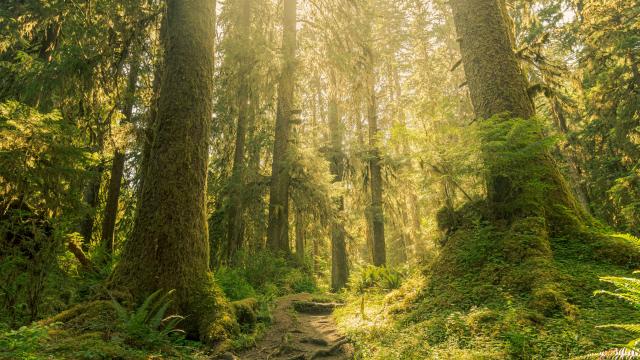In reversal of standard procedure, the federal government will now have to figure out how not to miss the trees for the forest.
On Friday, as part of an apparent Earth Day push, President Biden signed an executive order directing the Departments of the Interior and Agriculture to survey and catalogue the country’s oldest trees on federal land and to “strengthen” our forests against the threat of wildfire. The official announcement of the new order came late morning Pacific time from Seward Park in Seattle, during Biden’s first visit to the Pacific Northwest since being elected.
“Today I’m signing an executive order to conserve our forests that do so much to protect us,” said the president in a speech. “We’re going to work with state and local and tribal governments to map and catalogue and then conserve old-growth forests on public lands.”
In a press statement and in Biden’s remarks, the administration framed the policy as being a climate change mitigation effort, pointing out the role of forests in absorbing and storing carbon dioxide. But there are limits to what trees can do, especially as U.S. emissions continue to rise. And though the order is a small step toward better forest protections, it certainly isn’t comprehensive.
What the order does concretely promise is the “first ever inventory of mature and old-growth forests on federal lands,” according to the White House statement. Part of that project would be establishing a consistent set of definitions surrounding old-growth trees, which doesn’t currently exist. And the statement promises the results of that nationwide survey will be completed and released publicly within a year.
It’s hard to protect something you don’t even know exists, so a federal survey of old growth is a good thing, even if it’s not enough. But finding and counting the largest and oldest trees across all 640 million acres of federal U.S. land isn’t a simple proposition. Beyond there being no agreed-upon definition of what is and isn’t an old-growth tree, different tree species grow at very different rates, and the circumstances an individual tree matures in affect its growth. You can’t just look at any old tree and know with certainty how long it’s been around. It’s unclear exactly how surveying will be conducted, and the White House didn’t immediately respond to Gizmodo’s request for comment.
In addition to the carbon sequestration capacity of forests, the order references the important role old-growth trees play in boosting ecosystems’ resilience to wildfires. Larger trees are less susceptible to burning during fires and can provide the basis of forest recovery post-burn through their survival and seeds.
The press statement says that, after data collection, the USDA and Department of the Interior will “develop new policies…to institutionalise climate-smart [forest] management and conservation,” in response to the threats of wildfire and drought.
Notably, though, what the order does not do is stop ancient trees from being logged. Environmental groups have been publicly calling on the administration to ban logging of old-growth trees on federal land since February. Yet, the White House statement mentions nothing on U.S. logging and the threat it poses to old growth trees at all. Instead, it offers a vague promise to “combat” the practice of cutting down trees to expand farmland (by producing a report on the issue). The statement also vows unspecified “support [for] sustainable forest management around the world.”
Trees do sequester carbon, and older, bigger trees even more so than others. But trees alone cannot prevent worsening climate change, and it’s hard to interpret this executive order as an earnest climate action, given all of the other ways Biden has failed to keep his environmental promises.
Just last week, the administration announced that it would allow new oil and gas drilling on federal land–an action directly counter to what the president had said while on the campaign trail. “No more drilling on federal lands, period,” Biden stated at a 2020 New Hampshire campaign event.
So it turns out, on this Earth Day, it’s not just polluting companies and the Koch brothers getting in on the greenwashing. And if that makes you sad, may I suggest you listen to the tired, trope-ridden, responsibility-deflecting advice of the president himself? “Every time I get a little down,” said Biden in his speech, “I just turn on the television or I take a look at all the young people. This young generation is not gonna put up with all this stuff. No they’re not. They are really, really energised.”
The young folk may be energised, but this executive order is sadly a dud.
Editor’s Note: Release dates within this article are based in the U.S., but will be updated with local Australian dates as soon as we know more.
